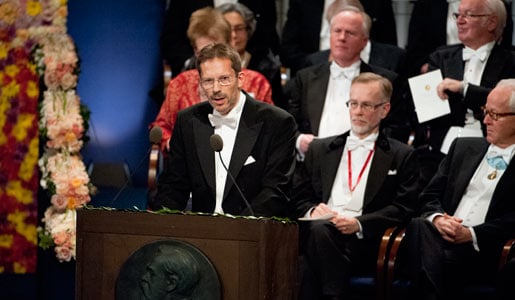Award ceremony speech
English
Presentation Speech by Professor Thomas Perlmann, Member of the Nobel Assembly at Karolinska Institutet, Member of the Nobel Committee for Physiology or Medicine, 10 December 2012

Professor Thomas Perlmann delivering the Presentation Speech for the 2012 Nobel Prize in Physiology or Medicine at the Stockholm Concert Hall.
Copyright © Nobel Media AB 2012
Photo: Alex Ljungdahl
We can assume that more than one of us here at the Stockholm Concert Hall has sometimes thought it might be desirable to once again be young, wild and maybe a little crazy – and perhaps be offered the opportunity to grow up another time and try a different path than the one we chose early in life. Now, if this person were not an adult human being but instead a mature cell, such a journey through time would actually be possible. This has been demonstrated through the discoveries that are being honoured with this year’s Nobel Prize in Physiology or Medicine.
Each of us developed from a fertilised egg cell that – by means of cell divisions – gave rise to all the different types of cells that form a complete human being. During this controlled developmental process, immature cells successively form all the specialised cell types found in our organs, such as the liver, lungs and brain.
For a long time, it was believed that this could only be a one-way journey. After all, development always progresses from immature cells in the early embryo towards specialisation in adult humans. It was assumed that perhaps cells do not retain all the genetic information that is needed to produce all types of cells, so the return journey is no longer possible.
This picture fundamentally changed as a result of John Gurdon’s cloning experiments, which were published in the 1960s. Gurdon destroyed the nucleus with its genetic material in a frog’s egg and replaced it with the nucleus from an intestinal cell of a tadpole. Even though its genetic material came from a specialised intestinal cell, the altered frog’s egg was still able to develop into all sorts of mature cells in an adult frog. Gurdon had thus demonstrated that all the information needed to regenerate all of the animal’s cells is preserved during cell development. He had carried out the first cloning of a vertebrate.
These findings surprised the research community, and it took time before Gurdon’s discovery became generally accepted. But his findings were confirmed, and most people have heard of Dolly, the world’s first cloned mammal – a sheep that was produced according to the principle that Gurdon had used in his frog experiments.
More than 40 years after Gurdon’s discovery, Shinya Yamanaka performed experiments that signified a new scientific breakthrough in the field. Gurdon had shown that the journey back to an immature state is possible. But could this journey take place in a mature cell, without the help of an egg cell? Was it instead possible to find genes that could start the return journey in a mature cell? Yamanaka selected genes that are important to immature so-called pluripotent stem cells and introduced them into mature skin cells. A combination of only four genes proved sufficient. These findings amazed the research world, since few could have imagined that such a simple recipe could return mature cells to the stem cell stage.
The publication of Yamanaka’s findings in 2006 triggered amazingly rapid advances. Human skin cells can now be reprogrammed into stem cells, and in tissue cultures they can form nerve cells or heart muscle cells, for example. We now have access to entirely new tools for a better understanding of diseases and for the development of new diagnostics and therapies.
This year’s Laureates have thus provided mature cells with a return ticket. They have thereby fundamentally changed our view of human development and cell specialisation.
Professor Gurdon and Professor Yamanaka,
Your groundbreaking research has demonstrated that it is possible to unlock the differentiated state and allow mature cells to return to an immature state from which all types of cells can be derived. Your discoveries have provided entirely new tools of immense value for the development of new diagnostics and therapies. On behalf of the Nobel Assembly at Karolinska Institutet, I wish to convey to you our warmest congratulations. May I now ask you to step forward to receive the Nobel Prize from the hands of His Majesty the King.
Nobel Prizes and laureates
Six prizes were awarded for achievements that have conferred the greatest benefit to humankind. The 14 laureates' work and discoveries range from quantum tunnelling to promoting democratic rights.
See them all presented here.
